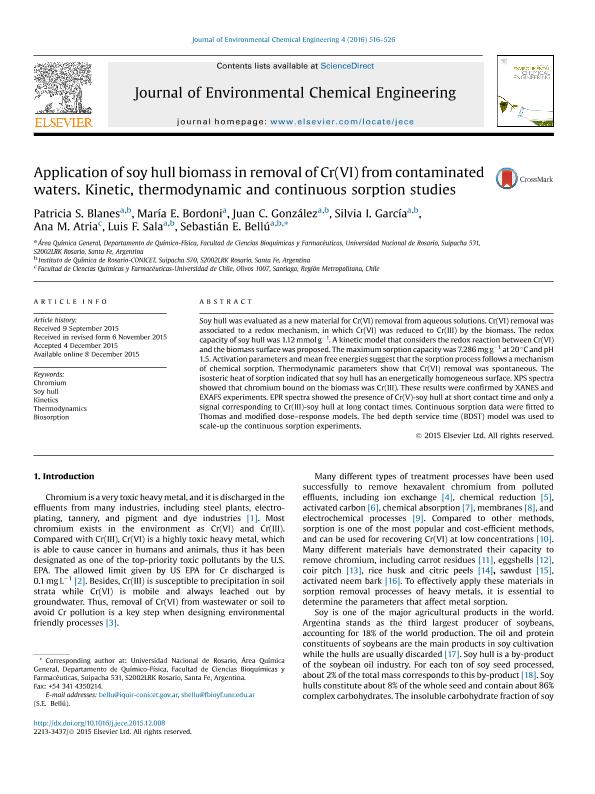Artículo
Application of soy hull biomass in removal of Cr(VI) from contaminated waters. Kinetic, thermodynamic and continuous sorption studies
Blanes, Patricia Silvia; Bordoni, María E.; González, Juan Carlos; García, Silvia Isabel; Atria, Ana M.; Sala, Luis Federico ; Bellú, Sebastián Eduardo
; Bellú, Sebastián Eduardo
 ; Bellú, Sebastián Eduardo
; Bellú, Sebastián Eduardo
Fecha de publicación:
12/2015
Editorial:
Elsevier
Revista:
Journal of Environmental Chemical Engineering
ISSN:
2213-3437
Idioma:
Inglés
Tipo de recurso:
Artículo publicado
Clasificación temática:
Resumen
Soy hull was evaluated as a new material for Cr(VI) removal from aqueous solutions. Cr(VI) removal was associated to a redox mechanism, in which Cr(VI) was reduced to Cr(III) by the biomass. The redox capacity of soy hull was 1.12 mmol g-1. A kinetic model that considers the redox reaction between Cr(VI) and the biomass surface was proposed. The maximum sorption capacity was 7.286 mg g-1 at 20 ºC and pH 1.5. Activation parameters and mean free energies suggest that the sorption process follows a mechanism of chemical sorption. Thermodynamic parameters show that Cr(VI) removal was spontaneous. The isosteric heat of sorption indicated that soy hull has an energetically homogeneous surface. XPS spectra showed that chromium bound on the biomass was Cr(III). These results were confirmed by XANES and EXAFS experiments. EPR spectra showed the presence of Cr(V)-soy hull at short contact time and only a signal corresponding to Cr(III)-soy hull at long contact times. Continuous sorption data were fitted to Thomas and Modified Dose- Response models. The bed depth service time (BDST) model was used to scale-up the continuous sorption experiments.
Palabras clave:
Chromium
,
Soy Hull
,
Kinetics
,
Thermodynamics
,
Biosorption
Archivos asociados
Licencia
Identificadores
Colecciones
Articulos(CCT - ROSARIO)
Articulos de CTRO.CIENTIFICO TECNOL.CONICET - ROSARIO
Articulos de CTRO.CIENTIFICO TECNOL.CONICET - ROSARIO
Articulos(IQUIR)
Articulos de INST.DE QUIMICA ROSARIO
Articulos de INST.DE QUIMICA ROSARIO
Citación
Blanes, Patricia Silvia; Bordoni, María E.; González, Juan Carlos; García, Silvia Isabel; Atria, Ana M.; et al.; Application of soy hull biomass in removal of Cr(VI) from contaminated waters. Kinetic, thermodynamic and continuous sorption studies; Elsevier; Journal of Environmental Chemical Engineering; 4; 1; 12-2015; 516-526
Compartir
Altmétricas



